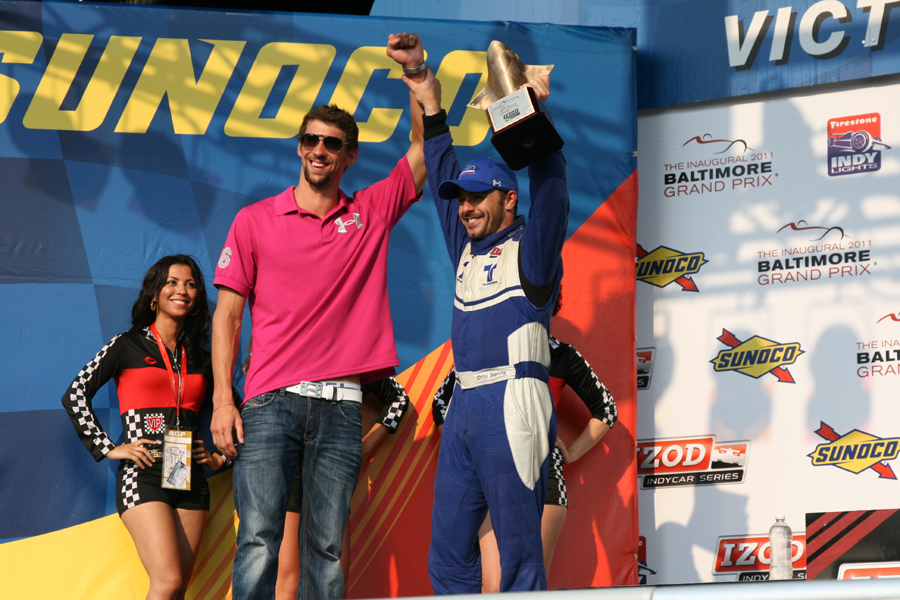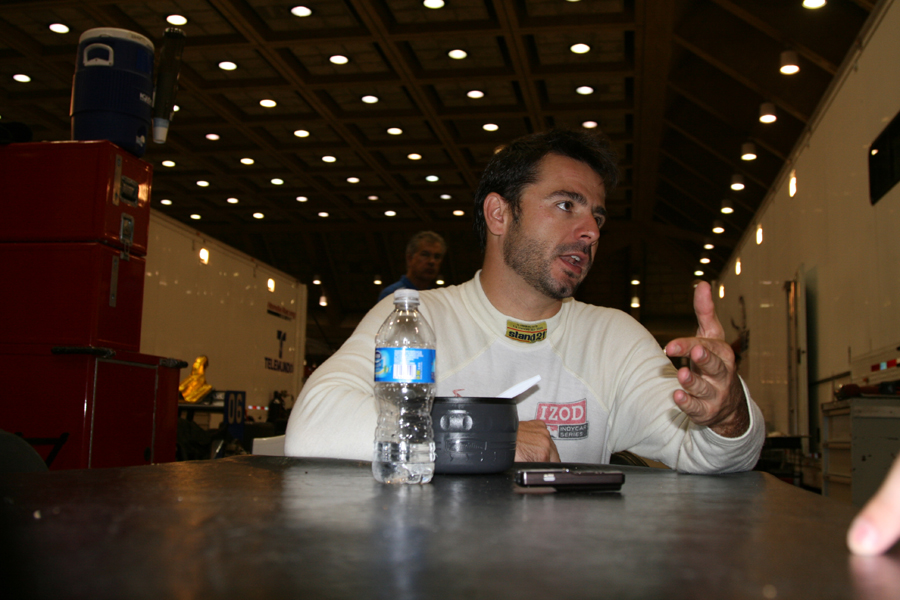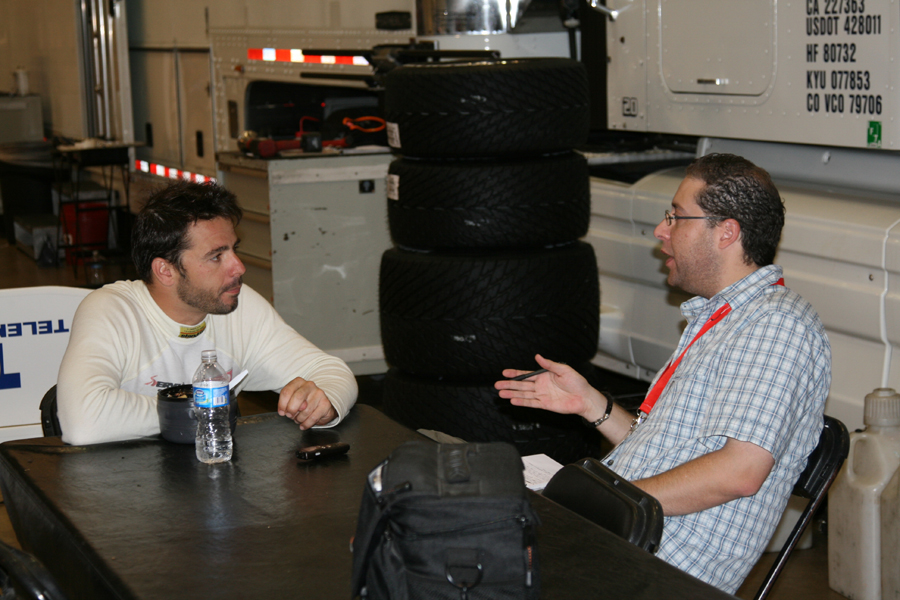Back on Track: An Interview with Oriol Servià
- Written by The Driver
- Published in Auto Racing
- font size decrease font size increase font size
- Be the first to comment!

Like many eminent race-car drivers, Oriol Servià began his career in go-karting, but he never imagined that his future would be in professional racing. Whereas many of the most successful drivers are groomed for the position from an early age (often to the detriment of their education and development), racing was initially just a hobby for Servià, whose father became a Spanish rally champion while at the same time working a full-time job. Servià is the only current IndyCar driver who is also a college graduate, having completed a degree in mechanical engineering at the Universitat Politècnica de Catalunya.
The past few years have been unkind to Servià, who struggled to secure enough sponsors to fund a full-time ride. But at the start of the 2011 season, he rejoined Newman/Haas Racing, a team he’d raced for in the past, and the reunion couldn’t have come at a better time for either side. With rookie driver James Hinchcliffe now onboard, Newman/Haas has become a force to be reckoned with.
Servià’s hiatus from the track certainly did not diminish his skills: he currently sits fourth in the IndyCar driver’s championship with 367 points, trailing Target Chip Ganassi’s Scott Dixon by 63 points. Servià has been an important part of Newman/Haas’s turnaround this season: in last year’s IndyCar campaign, their highest-ranked driver was Hideki Mutoh, who finished the season 18th in the driver’s standings with 250 points. Their best result was in Toronto, where young Graham Rahal finished a surprising fifth.
So far this year, Servià has met and exceeded his team’s expectations, emerging as one of the most consistent drivers in the field. He’s had six top-five finishes, including two second-place finishes, and one of those was nearly a first-place finish at the New Hampshire Motor Speedway, but the result was unsuccessfully appealed. Servià also leads all drivers in laps completed, having missed only eight laps to date.
We had the good fortune to sit down recently and chat with the 37-year-old veteran about how he got started in racing, his impressions of the season so far, his thoughts on the decision in New Hampshire, and his views on what next year might bring.

The Driver: How did you first get into driving?
Oriol Servià: In my case it was very progressive. I had my first motorcycle when I was only two and a half years old, and then at the age of four I received my first go-kart. My dad was a Spanish rally champion, so he got me into racing at a very young age. As a kid, I was always around racing because I would go to my father’s races. My father raced often as a hobby, [but] he always had a normal job on top of it, so in my head I thought “I hope I can race as a hobby too.” I never thought it would be a profession until I came to the Indy Lights series in 1998 and won the championship in 1999. That got me to realize that the race-car drivers on this circuit actually do this for a living.
I went to college and made a deal with them that I always had to keep up my studies. So I went to school to become an engineer in Spain and had a great time. It gave me a broader view of life and helps me when I communicate with my engineers. I had a very different learning curve from other drivers: most start early and focus on racing. They don’t have time for school. I wouldn’t change it, and I hope it’s an advantage for me.
TD: Were there any race car drivers that you admired growing up?
Servià: My hero in those days was my father – I didn’t really admire anyone else. My favourite driver was Nigel Mansell, especially when he battled Ayrton Senna and Alain Prost. In 1992, when I competed in a go-kart event in Paris, I had the chance to meet Senna and I felt I could speak some Portuguese with him. I turned to him to speak, [but] it was the only time in my life when I felt this special aura surrounding someone. It really caught me by surprise since I wasn’t a big fan [but] was just tongue tied. After that meeting, I followed Senna, who wasn’t just a great driver, but also someone I felt was very special.
TD: This is your second go-around with Newman/Haas: what are your impressions of the season so far?
Servià: We are very pleased. In 2009, I only raced in four events for them, and in 2010 I didn’t race at all because I couldn’t get enough funding from my sponsors. On the flip side, Newman/Haas struggled a lot in 2009 and 2010, which were two of their worst years, so our expectations were low coming into this year. At the start of the year, I remember speaking to our senior chief engineer, Craig Hampson, about competing at the top with Will Power, and he said to me then that we would be lucky if we finished in the top ten.
Fast forward to now and we are fourth in points, which is an incredible accomplishment. We almost won the controversial Loudon event in New Hampshire a few weeks ago, which would have been a monumental victory for Newman/Haas. Actually, what we say is that we finished first, we just didn’t win.
We’ve been very happy with our performance. It’s just so competitive this year in IndyCar qualifying: all it takes is one mistake and you can drop from sixth to eighteenth. It’s happened to me a few times this year. The level of drivers is very competitive, and I truly believe that there are 15 drivers who have a good chance to win any given race. It’s just that Will [Power] and Dario [Franchitti] are on those perfect championship teams that are doing everything right.
TD: It seems that Newman/Haas has put together one of the best driver combinations on the grid. What are your thoughts about your teammate James Hinchcliffe and the rest of the squad?
Servià: It’s been a big boost to have James as a teammate. Having two cars is essential to compete with the Penskes and the Ganassis, who always run three to four cars. We are working hard as individuals and as a team to keep everyone together for next year and the years to come. It takes continuity to perform at a high level every year. When you look at Will Power, he’s had the same engineer since 2006. KV Racing’s Tony Kanaan had the most success in IndyCar with his previous engineer, who was with him for 11 years.
We have a great team with a lot of brainpower – as much as any other team. The cars never break down, and we have the best mechanics. Some of the crew members have been with the team for over 15 years, and there’s a reason for that. I think if we can wrap up plans for next year and start working on the new car no later than the other teams, we’ll be much further along than this year.

TD: You spent a year and a half removed from the sport: how did that prepare you for this year?
Servià: The time off just made me want to compete even more. It makes you realize that you want it bad enough to get back into the sport. First of all, you are not competing at all; second, you’re not making any money and you have to support your family. It ignited my fire once I got the opportunity with Newman/Haas.
TD: This year you’ve definitely proven that you deserve a seat in IndyCar and should be competing at every race. You’re currently 4th in the driver’s standings – how do you stay so consistent, especially given the combination of road and oval courses?
Servià: It’s funny: I came from Europe, [but] never competed on an oval track. The road courses I felt very comfortable with from my time in Europe. However, in my second year in Indy Lights, I was lucky to be on the Mears team with Casey Mears as my teammate. Roger Mears was the team manager and Rick Mears was Casey’s spotter. So I ended up learning the basics from the oval master himself, Rick Mears. He taught me how the car should feel and when you need to push it. I was just lucky to learn from the right guy at the right moment in Indy Lights, where I was able to perfect my craft. I believe that my consistency comes from that early training with the Mears team.
TD: I have to touch on what happened in New Hampshire. Take us through your views on what occurred after the restart and your thoughts on the appeal verdict.
Servià: Before the last yellow, I was surprised they were going to go green. Once you see the drops in the visor, the officials almost always call for the yellow flag. We were driving for at least a half hour in those conditions, but nobody was crashing. Once they called for the yellow flag, it slowly stopped raining. I was prepared for green when the race officials called it because it wasn’t as bad as before.
Going into the last corner, Ryan Hunter-Reay was not prepared and was still doing S’s. We got to the cone where we need to start to go green, [but] for some reason Hunter-Reay didn’t accelerate, so I went full power in second gear and passed him. The only problem was that his teammate Danica Patrick spun, which caused a big pile-up. Patrick later admitted that she made a mistake and was still in first gear when she accelerated. So there was only one car that spun. However, they called off that lap as if it had never happened and Hunter-Reay won the race, which to me was unfair. We had the lead when the race was stopped.
The team did an amazing job on the appeal. They thoroughly explained the rulebook to the panel and showed that I was ahead of Hunter-Reay before it went yellow. There’s no doubt in my mind – we had the proof. The rule doesn’t matter where you are: it’s when the yellow flag comes out – that’s when they freeze the field, and I was clearly ahead. I noticed that the panel was convinced, but unfortunately it was left in Brian Barnhart’s [President of Race Operations] hands, and he disregarded all the evidence. In the end, the lap was called off as if it had never happened because of the error in making the wrong call on restarting the race.
Andretti Autosport and Ganassi brought in their team of lawyers to the appeal and they didn’t care at all about the rules on yellow. All they kept saying was that the first rule in the rulebook is that Brian Barnhart has the discretion to decide who won the race when the race finishes. He can overrule anything, and he made it clear that he did not count that lap, so the panel had nothing to say.
Unfortunately, he has set a precedent for future races: now there is a chance that a lap can be waved off if the restart was in error. We all make mistakes, but we cannot go back in time. If I make a mistake while navigating a turn and crash into the wall, can I go back and tell them to not count it? No, and that’s why this ruling is unfair.
I’m very proud of the team, and I’ve been approached by many fans in support of winning in Loudon, but unfortunately we have to settle for being the nice team in this bad story.
TD: After a long career in Champ Car and IndyCar, do you feel at age 37 that you’re at the peak of your career and can now use your experience to compete for the championship next year?
Servià: I know so, especially if we can start working on the car at the same time as the others. If we have the team together, we can accomplish a lot and change the dynamic of IndyCar. It’s all about having the team ready for next season.
